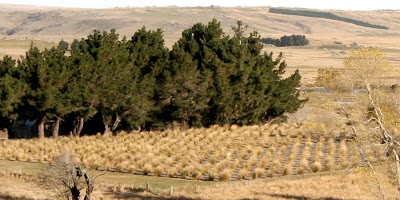
John Reynolds' Snow Tussock provides another good example of adventurous commissioning in the private sector. Described by the artist as New Zealand's slowest artwork (it will take decades to reach maturity), Snow Tussock (2003) was commissioned for a heritage park in East Otago which is being developed as a part of a post-mining rehabilitation strategy. The work is formed by 854 tussocks planted in a 70 x 70 metre grid in a field situated between an historic church and a small cemetery that traces the post-contact history (farming and mining) of Macraes Village and its surrounds.
Reynolds chose to work with the species Snow Tussock because it is a native plant under threat from annual burn-offs carried out by the local farming community. He highlights the need for a stronger environmental focus and more conservation programmes in a rural area where the landscape and its native flora and fauna play second fiddle to economic exploitation. And things are going from bad to worse in the East Otago region with more sheep and cattle farms being converted to dairy farms. The diary industry is one of the biggest contributors to the country's greenhouse gas emissions and under the Kyoto Protocol New Zealand must limit emissions to 1990 levels during the period 2008 - 2012. So far there are few signs of the dairy industry responding to the challenge.
Image: John Reynolds, Snow Tussock (2003), Macraes Village, East Otago, New Zealand
